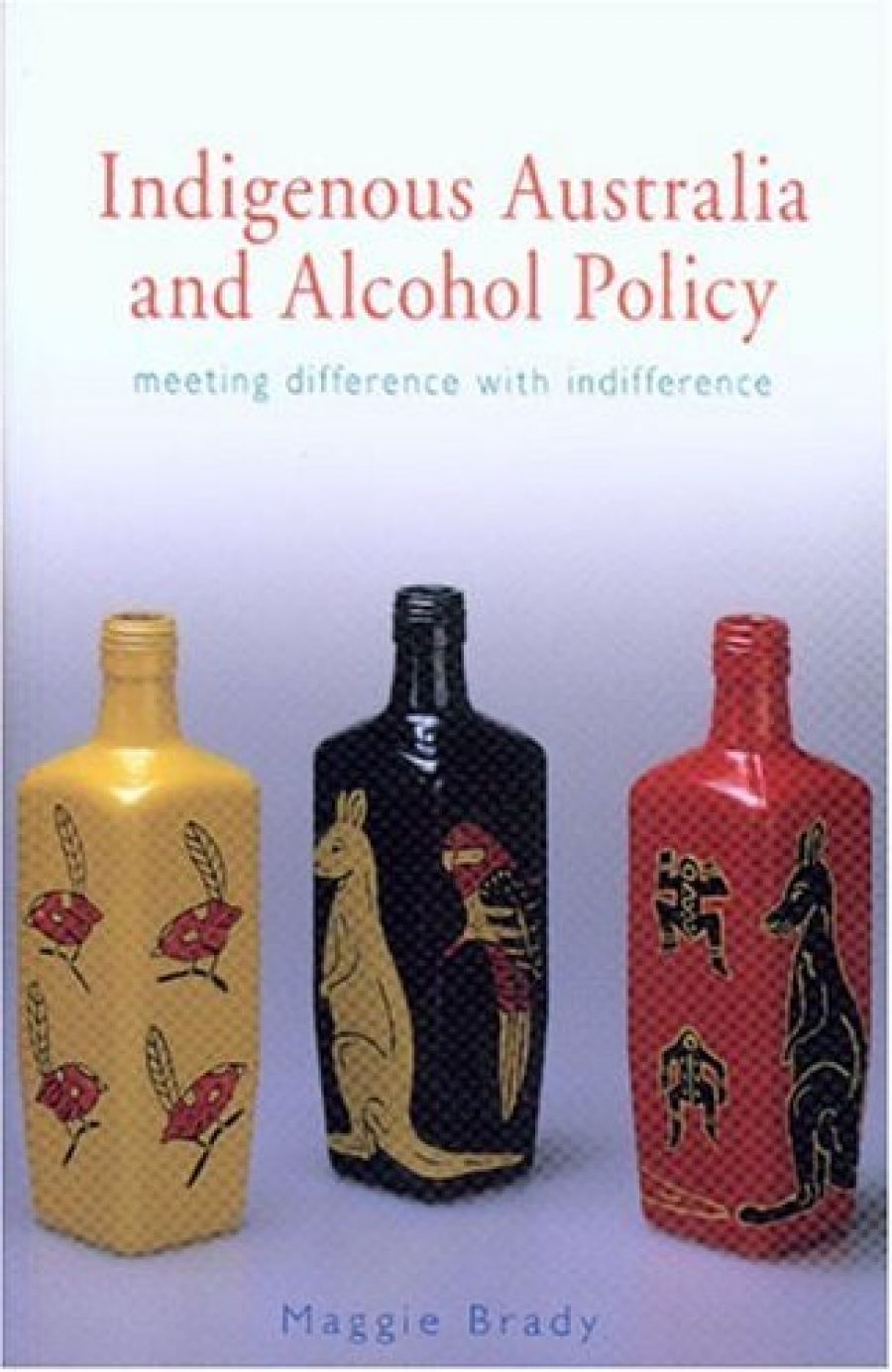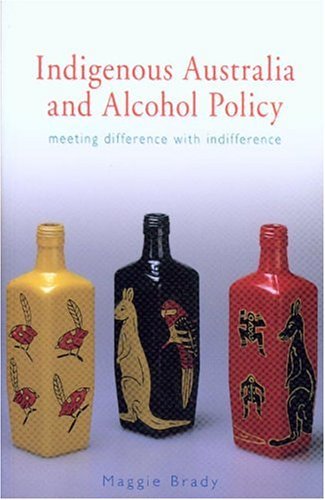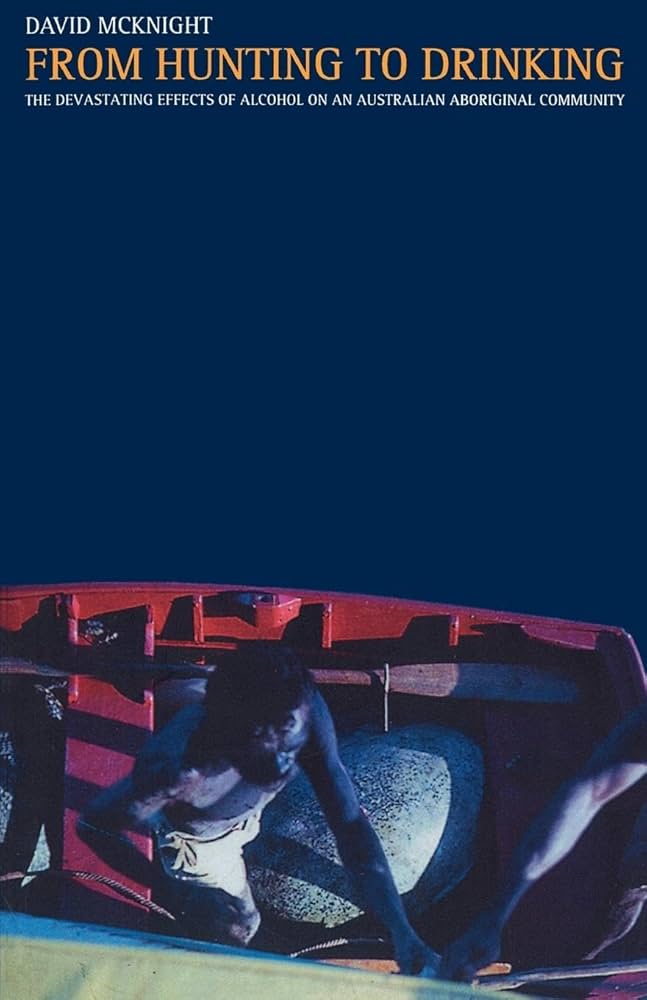
- Free Article: No
- Contents Category: Indigenous Studies
- Review Article: Yes
- Article Title: Bottom of the Bottle
- Online Only: No
- Custom Highlight Text:
In 2002, during the scandal and scrambling caused by Keith Windschuttle’s The Fabrication of Aboriginal History, an unassuming paperback made its way onto the shelf without much fanfare. No radio specials, opinion pieces or public debates followed its publication. Instead, David McKnight and his book From Hunting to Drinking: The Devastating Effects of Alcohol 011 an Australian Aboriginal Community slipped past Australian historians and intellectuals while they focused their attention elsewhere.
- Book 1 Title: Indigenous Australia and Alcohol Policy
- Book 1 Subtitle: Meeting difference with indifference
- Book 1 Biblio: UNSW Press, $39.95 pb, 168 pp
- Book 1 Cover Small (400 x 600):

- Book 1 Cover (800 x 1200):

- Book 2 Title: From Hunting to Drinking
- Book 2 Subtitle: The devastating effects of alcohol on an Australian Aboriginal community
- Book 2 Biblio: Routledge, $59 pb, 251 pp
- Book 2 Cover Small (400 x 600):

- Book 2 Cover (800 x 1200):

Even in 2004, McKnight is still only known by word of mouth. Those looking to see what side of the ‘history wars’ he is on will be disappointed. From Hunting to Drinking is not another myopic talc of black armbands or white blindfolds; it is a true story (and all the more powerful for that) about the way alcohol has devastated the small Aboriginal community on Mornington Island. McKnight’s work makes for confronting reading. He concludes: ‘the saddest part is that if the Mornington Islanders ever do turn away from alcohol they will discover that only a dim shadow of their traditional culture remains. They will literally have drunk away their culture.’ Two years is a long time for such words to go unread.
McKnight began visiting Mornington Island in 1966. In those early years we see him make friends with the locals and be initiated into their customs (he quickly learns to keep small notes in one pocket and larger ones in the other), and we get a picture of an Aboriginal community dealing with a new economy of everyday life. As the years pass, the picture continues to change. In the 1970s grog is allowed on the island, a canteen is built and the missionaries depart. Mornington Island is made a shire (a crude form of self-government) by the Bjelke-Petersen government. Although the shire increases the islanders’ rights, we see through McKnight’s up-close analysis that it has reduced the choices in their everyday lives.
McKnight follows the story to 1999. Many changes have occurred, none more devastating than the effect of alcohol on the community. Alcohol has a killer grip on the Mornington Islanders, especially on the young men. Through his matterof-fact prose, McKnight takes us on a confronting journey into this alcohol-fuelled world. He shows us how alcohol begins to dominate their everyday lives. And we see the havoc it causes: from the physical damage of young men found unconscious in an inch of beer on the canteen floor to the dangerous social change where ageing relatives are no longer respected for their knowledge but are exploited (and literally wheeled up to the canteen) by kin for their weekly entitlement of grog.
Some might claim that excessive drinking is not just a problem for Aboriginal communities; that such a focus on this kind of drinking just reinforces old stereotypes. And they would be right. Yet the journey we take with McKnight has little room for political sensitivities. Although we often wince at his words on the page, we begin to understand that this is not a case of dwelling on Aboriginal drinking: it is about finally hearing the real and terrible consequences that excessive drinking has had (and is still having, no doubt) on Mornington Island. As hard-headed as McKnight might seem, we soon realise that this sensitive material is in sensitive hands.
As we accompany McKnight on his travels, we note small changes in the Mornington Islanders’ daily life, which have such lasting effects. It might at first seem harmless that men start returning from hunting early so they can be at the canteen when it opens, but McKnight shows us in painful detail how much damage this change causes. Everyday living soon becomes focused on one act: drinking.
It is McKnight’s ability to take us into everyday life on Mornington Island that makes his work so revealing. By looking so closely at the effects of drinking on the community, we finally see the cause of the problem. Even though the canteen is the site of the problem, the real trouble stems from the imposed governance of the shire. Not only is the shire financially dependent on the Mornington Islanders’ drinking, it creates a social space in which the old practices of everyday living no longer have currency. The shire has done more than turn the Mornington Islanders’ world upside down: it has created an uneasy void that has been dangerously filled with whatever meaning one can find at the bottom of the bottle.
In Indigenous Australia and Alcohol Policy: Meeting Difference with Indifference, Maggie Brady takes us on a different journey into Aboriginal drinking. This time it is health policy that has failed Aboriginal communities. Her book offers a damning, stiff-lipped analysis of the issue. Simply put: drinking is a serious problem, it is socially devastating, and it must be addressed. For Brady, it is the inaction of the federal government and the continued emphasis on community-based approaches to indigenous health that have led to alcohol’s grip on Aboriginal communities across Australia.
Brady spells out the changes in policy relating to excessive drinking made by the federal government – the new emphasis on education and prevention (who has not seen some drinking advertisements on television aimed at ‘educating’ young drinkers?) – and how these changes have failed to reach Aboriginal communities. There are no sinister accusations, just a detailed and comprehensive account of how political and cultural sensitivities have allowed the problem of Aboriginal drinking to slip between the notion of difference and the action of indifference.
To Brady’s credit, this is not the sort of standard and inaccessible book about government policy one initially expects. Brady switches her focus from policy to the realities of drinking in Aboriginal communities, and we get a sense of the difficulties Aboriginal people face once they have stopped drinking. Kin networks are strong in Aboriginal communities, and Brady shows us the cultural problems Aboriginal men and women face as they are pressured by kin to fulfil their (new) obligation to drink. In this web of kin obligation, Brady points out that medical doctors are in a unique position to help Aboriginal men and women give up the grog. Doctors are able to act as authorising outsiders for Aboriginal people, allowing them, as Brady puts it ‘to externalise the blame for the decision to stop drinking’. Here we catch a different kind of sensitivity, not one surrounded by difference but one that allows old networks to be negotiated in new ways.
This need for choices is a shift away from the individual rights and towards the shared meanings of everyday living. McKnight and Brady show us that rights have little meaning when there is no functioning community to express them. While the problem of Aboriginal drinking is a sensitive issue, the realities that both authors compel us to face might finally turn us all in a new direction – away from the ideological battles of the history wars and towards an understanding that gives Aboriginal men and women control over the practices of their everyday life.


Comments powered by CComment